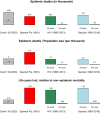Demographic perspectives on the mortality of COVID-19 and other epidemics
- PMID: 32820077
- PMCID: PMC7486771
- DOI: 10.1073/pnas.2006392117
Demographic perspectives on the mortality of COVID-19 and other epidemics
Erratum in
-
Correction for Goldstein and Lee, Demographic perspectives on the mortality of COVID-19 and other epidemics.Proc Natl Acad Sci U S A. 2020 Nov 24;117(47):29991. doi: 10.1073/pnas.2021355117. Epub 2020 Nov 2. Proc Natl Acad Sci U S A. 2020. PMID: 33139581 Free PMC article. No abstract available.
Abstract
To put estimates of COVID-19 mortality into perspective, we estimate age-specific mortality for an epidemic claiming for illustrative purposes 1 million US lives, with results approximately scalable over a broad range of deaths. We calculate the impact on period life expectancy (down 2.94 y) and remaining life years (11.7 y per death). Avoiding 1.75 million deaths or 20.5 trillion person years of life lost would be valued at $10.2 to $17.5 trillion. The age patterns of COVID-19 mortality in other countries are quite similar and increase at rates close to each country's rate for all-cause mortality. The scenario of 1 million COVID-19 deaths is similar in scale to that of the decades-long HIV/AIDS and opioid-overdose epidemics but considerably smaller than that of the Spanish flu of 1918. Unlike HIV/AIDS and opioid epidemics, the COVID-19 deaths are concentrated in a period of months rather than spread out over decades.
Keywords: COVID-19; demography; epidemic; life expectancy; mortality.
Copyright © 2020 the Author(s). Published by PNAS.
Conflict of interest statement
The authors declare no competing interest.
Figures




References
-
- Centers for Disease Control , Covid-19 forecasts: Cumulative deaths. https://www.cdc.gov/coronavirus/2019-ncov/covid-data/forecasting-us.html. Accessed 12 August 2020.
-
- Institut National d’Etudes Démographiques , The demographics of Covid-19 deaths. https://dc-covid.site.ined.fr/en/. Accessed 23 May 2020.
-
- Edwards R. D., Tuljapurkar S., Inequality in life spans and a new perspective on mortality convergence across industrialized countries. Popul. Dev. Rev. 31, 645–674 (2005).

